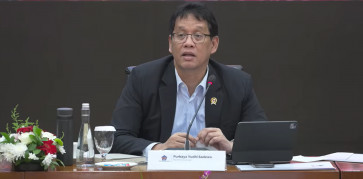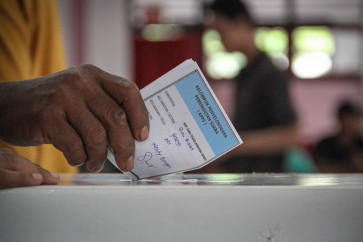Popular Reads
Top Results
Can't find what you're looking for?
View all search resultsPopular Reads
Top Results
Can't find what you're looking for?
View all search resultsHistory of ballet in Indonesia illuminated in ‘Historia’
Communal: Marlupi Dance Academy‘s Rakjat provides a more Indonesian take on dance compared to the previous performance of Don Quixote Suite
Change text size
Gift Premium Articles
to Anyone
C
ommunal: Marlupi Dance Academy‘s Rakjat provides a more Indonesian take on dance compared to the previous performance of Don Quixote Suite.
The history of ballet in Indonesia is being showcased in an exhibition and through dances by five Indonesian dance schools and the West Australian Ballet company.
In a country with a rich tradition of dance, ballet is one of the art forms that have become a staple of Indonesian dance schools.
With rigorous training that often starts when they are little, ballerinas are comparable in dedication to dancers specializing in the more traditional variants of the art.
To celebrate Indonesia’s small but vibrant ballet scene, a non-profit foundation, Ballet.id, recently held an exhibition that highlighted the nation’s history of ballet, from its beginnings in the early 20th century to its present-day state.
Held at the Gedung Kesenian Jakarta playhouse in Central Jakarta on July 6-7, “Historia: The Journey of Ballet in Indonesia” featured a modest exhibition of photographs, documents and clippings of articles on ballet in Indonesia, which began during a visit by Russian ballerina Anna Pavlova to Batavia on Feb. 21, 1929.
Throughout the years, ballet has mostly been taught by Dutch people, but some of their students would eventually start their own dance schools, like Farida Oetoyo (Ballet Sumber Cipta), Nanny Lubis (Namarina) and Marlupi Sijangga (Marlupi Dance Academy).
Indonesia’s only ballet company, the National Ballet, was founded in 1959 by Farida Oetoyo, Yulianti Parani, Jimmy Tan, Wim Roemers, Louis Pandelaki and Leska Ong.
In Farida’s biography Menari Di Atas Ilalang (Dancing on the Weeds) by Dorothea Rose Herliany, it is said the company only lasted for a year for a number of reasons, from lack of motivation and public appreciation to creative differences between the members.
Ballet.id founder and executive director Mariska Febriyani told The Jakarta Post that “Historia” started out as a small research project by co-founder Meutia Chaerani on the history of ballet in Indonesia.
“By small research [project], I meant it wasn’t envisioned to become a book, but was just done out of a love for ballet as an art form. It began in 2014 [and went on] through 2016, when it was halted because of a lack of funding, as it was a purely a personal project of passion,” Mariska said.
This was the first time the foundation has decided to hold an exhibition that tells the story of those who would eventually start their own dance schools.
“Historia” also featured performances that are related to the history of ballet in Indonesia.
Dancers from five Indonesian dance schools took part in the evening’s performance. They were Namarina Youth Dance, Marlupi Dance Academy, Ballet Sumber Cipta, Eksotika Karmawibhangga Indonesia (EKI) and Cicilia Ballet.
The program opened with Namarina’s Tradikal, an original piece choreographed by Dinar Karina that combines elements of classical ballet, contemporary and traditional Indonesian dances in a single performance.
Graceful moves influenced by classical ballet were juxtaposed with sharp, energetic ones clearly inspired by martial arts, creating a contrast of East and West.
Vivacious: Namarina’s opening piece Tradikal juxtaposes elements of martial arts and traditional dance with influences from classical ballet.Marlupi Dance Academy went for a more classical route by opening their segment with the Don Quixote Suite, a piece first performed in Russia in 1869 that would later be performed in other countries by Anna Pavlova.
A more Indonesian approach to dance is present in Rakjat, a more contemporary piece that evokes the Indonesian spirit of camaraderie and togetherness present in the nostalgia for festivals from the days of yore.
Meanwhile, Ballet Sumber Cipta paid tribute to Farida, who passed away in 2014, through an original contemporary ballet piece entitled Serdtse. Taken from the Russian word for “heart”, the piece was inspired by Farida’s diagnosis of the narrowing of her own blood vessels in 2006 and a resulting angioplasty procedure.
The performance feels much more somber in tone, in which movements are much more restrained yet expressive. A central point in the piece is the use of long stretches of red fabric, which when performed with dancers in red and a lone one in white, clearly suggests a creative interpretation of Farida’s medical procedure.
The evening’s performances were not strictly ballet, as EKI brought a much more modern and current variant of dance into the mix.
Although the piece is entitled Alter Ballet, it combined influences from four genres – Broadway, contemporary, traditional and urban.
Alter Ballet showcased EKI Dance Company’s repertoire of genres, from the theatrical and bombastic opening act and the traditional Bali-esque segment to the solo urban session set to Nicki Minaj.
As the last dance school to perform, Cicilia Ballet represented the classical side of ballet with Grand Pas De Quatre, with four dancers emulating the piece as it was performed in London in 1845 by the four great ballerinas of the time: Lucille Grahn, Carlotta Grisi, Fanny Cerito and Marie Taglioni.
As well as the five dance schools, “Historia” also marked the premiere of Australian choreographer Christopher Hill’s latest piece, One Together, which he specifically created for the occasion.
One Together was performed by the Indonesian Youth Ensemble 2019 – a group of young Indonesian dancers selected from an open audition in June.
Hill described the piece in a separate interview as his most complex creation, owing to the large group of 16 dancers, as well as the composition, which involved patterns, symmetry and cannon.
The special guests for the evening were from the West Australian Ballet company, where Hill spent four years before retiring in 2018 to focus on choreographing. The company brought dancers Dayana Hardy Acuna and Juan Carlos Osma, who performed at the end of the first and second part of “Historia”.
While White Swan Pas De Deux clearly showed Acuna and Osma’s classical training, the highlight was the excerpt of In-Synch as the finale, in which the performance’s improvised nature meant the work was created live in front of the audience.
“Historia” was attended by a number of diplomatic guests, including Australian Ambassador to Indonesia Gary Quinlan, who described ballet as a fascinating form of art because of its focus on movement and the human body.
“We Australians have actually got quite a lot to learn in terms of our development of our dance, particularly the dance that’s based on our indigenous cultures, but also more contemporary dance from the development of dance here,” Quinlan said. (ste)
Duet: Dayana Hardy Acuna and Juan Carlos Osma of West Australian Ballet‘s performance of In-Synch is improvised in nature.— Photos by JP/Wienda Parwitasari












